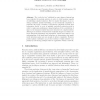Free Online Productivity Tools
i2Speak
i2Symbol
i2OCR
iTex2Img
iWeb2Print
iWeb2Shot
i2Type
iPdf2Split
iPdf2Merge
i2Bopomofo
i2Arabic
i2Style
i2Image
i2PDF
iLatex2Rtf
Sci2ools
ECAL
2007
Springer
2007
Springer
Spatial Embedding and Complexity: The Small-World Is Not Enough
The “order for free” exhibited by some classes of system has been exploited by natural selection in order to build systems capable of exhibiting complex behaviour. Here we explore the impact of one ordering constraint, spatial embedding, on the dynamical complexity of networks. We apply a measure of functional complexity derived from information theory to a set of spatially embedded network models in order to make some preliminary characterisations of the contribution of space to the dynamics (rather than mere structure) of complex systems. Although our measure of behavioural complexity hinges on a balance between functional integration and segregation, which seem related to an understanding of the small-world property, we demonstrate that smallworld structures alone are not enough to induce complexity. However, purely spatial constraints can produce systems of high intrinsic complexity by introducing multiple scales of organisation within a network.
Artificial Intelligence | Behavioural Complexity Hinges | Dynamical Complexity | ECAL 2007 | Functional Complexity |
| Added | 07 Jun 2010 |
| Updated | 07 Jun 2010 |
| Type | Conference |
| Year | 2007 |
| Where | ECAL |
| Authors | Christopher L. Buckley, Seth Bullock |
Comments (0)

